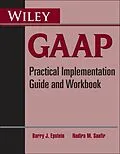Wiley GAAP Workbook provides easy-to-understand guidance
and clarity to practical applications of GAAP. Enhancing your
comprehension of GAAP to enable practical application of a variety
of situations that you may encounter in practice, this workbook and
guide simplifies application of GAAP standards and interpretations
to specific real-world situations.
* Provides easy-to-understand clarity and guidance on
interpretation and application of the overwhelming and voluminous
GAAP standards
* Offers explanations supplemented with examples, case studies,
solutions, and illustrations for enhanced understanding of
GAAP
* Includes newly issued accounting pronouncements and information
on the GAAP codification
Wiley GAAP: Practical Implementation Guide and Workbook
is a quick reference guide on Generally Accepted Accounting
Principles and their application with easy to understand outlines
of FASB standards, practical insights, case studies with solutions,
illustrations, and multiple choice questions with solutions. It
greatly facilitates understanding of the practical implementation
issues involved in applying these complex rules-based
standards.
Autorentext
BARRY J. EPSTEIN, PHD, CPA, the lead coauthor of Wiley GAAP and Wiley IFRS, is a partner with Russell Novak & Company LLP in Chicago. His work is centered on technical consultations on GAAP, IFRS, and auditing standards, and he serves as a consulting and testifying expert on commercial litigation, accountants' liability, and white-collar criminal matters.
NADIRA M. SAAFIR, CPA, is a senior litigation consultant with Chicago-based Russell Novak & Company LLP. Prior to joining the firm in 2009, she served as a senior auditor at Deloitte, where she gained an extensive knowledge base regarding the theory and practical application of Generally Accepted Accounting Principles and International Financial Reporting Standards, with particular emphasis on accounting and auditing for complex financial instruments.
Klappentext
The only practitioners' handbook providing intuitive, easy-to-understand, yet comprehensive guidance for the practical application of GAAP
Enhance your comprehension for the application of GAAP to every situation you may encounter in practice. Wiley GAAP: Practical Implementation Guide and Workbook offers clear, easily applied guidance for application of GAAP standards and interpretations to your real-time situations.
Take a look inside and you'll find:
- Straightforward guidance on interpretation and application of the overwhelming and voluminous GAAP standards
- Detailed explanations supplemented with examples, case studies, solutions, and illustrations for enhanced understanding of GAAP
- Newly issued accounting pronouncements and information on the GAAP codification
Find everything you need to know to apply GAAP standards in Wiley GAAP: Practical Implementation Guide and Workbook. It's the only tool you'll use to ensure your company gets GAAP done right.
Zusammenfassung
Wiley GAAP Workbook provides easy-to-understand guidance and clarity to practical applications of GAAP. Enhancing your comprehension of GAAP to enable practical application of a variety of situations that you may encounter in practice, this workbook and guide simplifies application of GAAP standards and interpretations to specific real-world situations.
- Provides easy-to-understand clarity and guidance on interpretation and application of the overwhelming and voluminous GAAP standards
- Offers explanations supplemented with examples, case studies, solutions, and illustrations for enhanced understanding of GAAP
- Includes newly issued accounting pronouncements and information on the GAAP codification
Wiley GAAP: Practical Implementation Guide and Workbook is a quick reference guide on Generally Accepted Accounting Principles and their application with easy to understand outlines of FASB standards, practical insights, case studies with solutions, illustrations, and multiple choice questions with solutions. It greatly facilitates understanding of the practical implementation issues involved in applying these complex rules-based standards.
Inhalt
About the Authors vii
Chapter 1 Researching GAAP 1
Chapter 2 Statement of Financial Position (ASC 210) 25
Chapter 3 Income Statement (ASC 225) 31
Chapter 4 Statement of Cash Flows (ASC 230) 37
Chapter 5 Accounting Policies, Changes in Accounting Estimates and Errors (asc 250) 43
Chapter 6 Fair Value (ASC 820) 53
Chapter 7 Cash, Receivables, and Prepaid Expenses (asc 305, 310, 860) 67
Chapter 8 Inventory (ASC 330) 81
Chapter 9 Revenue Recognition (ASC 605) 99
Chapter 10 Property, Plant, and Equipment (ASC 360) 107
Chapter 11 Financial Instruments (ASC 825) 115
Chapter 12 Equity Method Investments and Joint Ventures (ASC 323) 155
Chapter 13 Intangible Assets (ASC 350) 169
Chapter 14 Consolidated and Separate Financial Statements (ASC 810) 183
Chapter 15 Business Combinations (ASC 805) 191
Chapter 16 Income Taxes (ASC 740) 207
Chapter 17 Current Liabilities and Contingencies (Various Sections under the ASC) 227
Chapter 18 Long-Term Liabilities (ASC 480 and 835) 249
Chapter 19 Leases (ASC 840) 261
Chapter 20 Segment Reporting (ASC 280) 271
Chapter 21 Interim Reporting (ASC 270) 277
Chapter 22 Foreign Currency (ASC 830) 283
Chapter 23 Earnings Per Share (ASC 260) 297
Chapter 24 Employee Benefits (ASC 715) 305
Chapter 25 Accounting and Reporting by Retirement Benefit Plans (ASC 960 and 962) 323
Chapter 26 Stockholders' Equity (ASC 505) 331
Chapter 27 Personal Financial Statements (ASC 274) 345
Answers for Multiple-Choice Questions 353
Index 357
